Long Life Noodles (yī miàn, 伊面) or yi mein, symbolize longevity and can always be found on the banquet table at Chinese celebrations.
Long noodles, long life, right? (We should make a t-shirt.) Actually, any type of long noodles symbolizes longevity, but Yi Mein (also known as e-fu noodles—try not to get confused by all these names flying around…yi mein is what I have known them as since I first tasted them as a chubby little kid, and it makes no difference to me!) are a more festive and traditional take on the idea.
Whether it’s a birthday, a new baby, a wedding, or a lunar new year banquet, long life noodles are an important aspect of all these happy events. If you’re lucky enough to have attended a Chinese banquet, you already know that Long Life Noodles and Banquet Fried Rice are two of the last items served.
Most people are so stuffed midway through the 10-course feast that these two last dishes are the straws that break the camel’s back, and they usually find their way into take-out containers.
There’s always someone—your weird uncle or chatty cousin—who wasn’t fast enough with their chopsticks or was circulating around the banquet hall too much to have time to eat, and makes a beeline for those takeout containers full of starchy goodness.
That said, the long life noodles at large Chinese banquets can often be a bit soggy and tasteless, which is the problem with cooking them in large batches. That’s why it’s all the more worth it to make them at home. These noodles are deliciously simple––usually served with some mushrooms and/or Chinese garlic chives.
In addition to symbolizing longevity, eating noodles also signifies prosperity and good luck, which is why serving any kind of noodles for Chinese New Year (which is almost here!) is a good idea.
Yi Mein is often the noodle of choice due to its unique texture and taste, the result of using sodium bicarbonate or soda water for the dough. The noodles are also deep-fried before they are dried, which gives them a unique and slightly spongy texture.
Yi Mein noodles can be found in your Asian grocery store, usually in a red box with directions on how to prepare them. But like every successful recipe that is definitely *not* found on the side of a box, there are some important tips and tricks to know!
In this recipe, we’ll show you how to make these long life noodles so they have the perfect taste and texture for all your miscellaneous longevity needs. Let’s start!
The world loves these noodles, though many of us know them primarily through their pre-cooked and deep-fried variation: instant ramen. To make these noodles the traditional way, a dough made from high-gluten flour is twisted and stretched by hand, with some cooks making a show of banging the strands on their work tables to shake off the excess flour. Through their movements, la mian makers exercise control over the thickness of their noodles. Oftentimes, restaurants will offer a choice between la mian and dao xiao mian for your soups. In Central Asia, these noodles are known as “laghman.” One of the most well-known iterations is lanzhou la mian, a beef soup garnished with fresh aromatics.
Noodles, with the exception of zoodles (please go away), are the arguably the perfect food. This brilliant food genus, which includes everything from rigatoni to udon, banh pho to spaetzle, seems to have endless permutations to slurp, swirl, and stir-fry. Few countries know the joy of noodles better than China, where the foodstuff spread, evolved, and became an integral part of its culinary history for over 4,000 years.
If you search for these noodles, aka “knife-cut noodles,” on YouTube, prepare yourself to be amazed. The making of these noodles is a technical marvel, with cooks using razor-like implements to rapidly shave noodles off of a piece of dough, shooting them straight into a pot of boiling water to cook. Each batch requires expert timing: The cook has to cut the noodles quick enough that the first ones don’t overcook. These imperfectly shaped strands are chewy, with a slurpability that makes them great with soups or braised meat. You’d also do well to pair these with Uyghur dishes like a hearty lamb-and-vegetable stir-fry.
If you spend your weekends creepin’ on your local dim sum parlor, you know these well. Cheung fun are pillow-soft and jelly-like noodles that are made into sheets and often wrapped around a savory filling of shrimp, meat, or fried dough. Eating the dim sum version is, incidentally, a lot like the feeling of having a perfectly warm towel laid on your face. In Hong Kong, the noodles are served at street stalls in little rolls and topped with hoisin sauce, soy sauce, and sesame seeds. Their classic, jiggly texture comes from a mixture of rice flour and tapioca or glutinous rice flour, and the name translates literally to “intestine noodle” because of its aesthetic similarity to pig intestine. You can steam these at home or buy premade fresh noodles at some Asian grocers.
Some might argue that these aren’t noodles. To them, I’d say: Who hurt you? Detractors aside, these rice cakes are made from dense rolls of pounded glutinous rice that are steamed, then sliced on a bias into thin pieces. If you’re familiar with Japanese mochi, you can probably imagine how nian gao works. Served as a sweet dish in other parts of the country, the Shanghainese variation is distinctively savory. In stir-fried chao nian gao, the soft and chewy texture makes the perfect foil to crunchy vegetables. At the grocery store, you’ll probably find the Korean variation, called tteok—those are fine for both Korean and Chinese recipes.
Chow Mein vs. Lo Mein Noodles
If you confuse chow mein for lo mein and vice versa, you’re not alone. It is easy to see the word “mein” and assume they are the same dish. However, “mein” simply means “noodles,” which means mixing up chow mein and lo mein is similar to confusing tortellini with ravioli — both culinary terms refer to a type of Italian pasta, but they are distinct.
In English, chow mein means fried noodles and lo mein translates to tossed or stirred noodles. Because both dishes are variations of noodles, the main difference in chow mein and lo mein lies in how the noodles are prepared. These are the main differentiators between the preparation styles for each Chinese noodle dish:
Despite their differences, chow mein and lo mein dishes are both made with Chinese egg noodles, which are wheat flour noodles with egg added. While lo mein requires fresh egg noodles, chow mein can be made with either fresh or dried egg noodles.
Regardless of whether you use fresh or dried egg noodles, you will need to soften the noodles in boiling water before cooking them. The goal of boiling the egg noodles is to get them to the point where they are just barely cooked, and not yet too soft. This texture is what is generally referred to as “al dente” in Italian cooking, which means “cooked to the tooth.”
Fresh egg noodles only need to be boiled for a couple of minutes, whereas dried egg noodles must be parboiled in boiling water for about five minutes before they’re ready to be cooked with. Keep in mind that the exact amount of cooking time will vary depending on the thickness of the noodles, so be sure to follow the package instructions for each kind of noodle.
If you are unable to find noodles that are specifically labeled as chow mein noodles or lo mein noodles, you can use linguine noodles or regular Italian spaghetti noodles as a similar substitute.
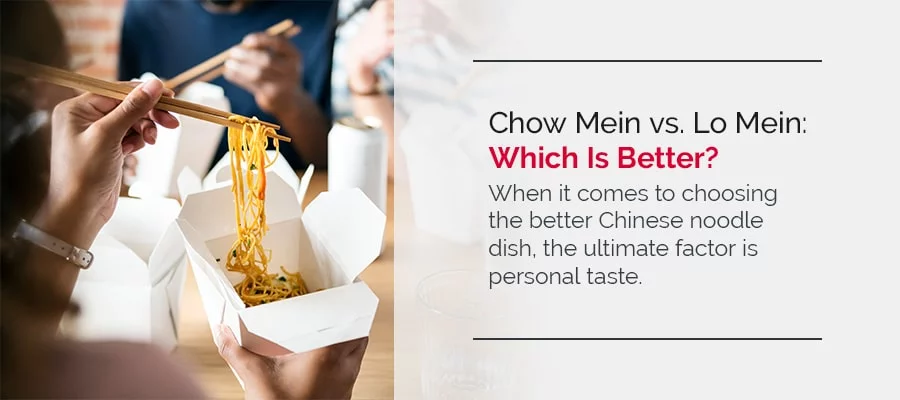
Chow Mein vs. Lo Mein: Which Is Better?
When it comes to choosing the better Chinese noodle dish, the ultimate factor is personal taste. While some noodle lovers enjoy the crunch of dried egg noodles expertly stir-fried into a delicious chow mein dish, others prefer a heaping bowl of steaming, sauce-soaked lo mein.
Your noodle texture choice will often depend on your other ingredients. Consider pairing crunchy chow mein noodles with softer ingredients like cooked mushrooms, juicy tomatoes and bean sprouts, and adding tougher ingredients like carrots, broccoli, celery and snow peas to your lo mein dishes.
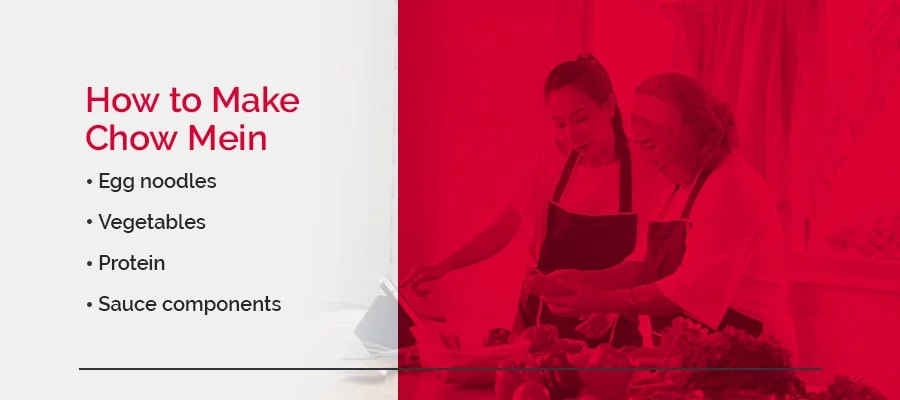
If all this talk about chow mein and lo mein is making you hungry, you might want to know how to make these noodles dishes on your own. Before explaining how to whip up a batch of chow mein, let’s discuss why you should choose this dish for dinner. Along with the delectable tastes and textures, here are some of the top reasons to make chow mein:
Before you start cooking your chow mein, gather these chow mein noodles ingredients:
Be sure all your chow mein ingredients are chopped, prepped and ready to go before starting the cooking process because a hot wok cooks ingredients extremely fast. Although a wok is the best and most traditional way to prepare chow mein, you can use a regular skillet if you do not own a wok. Just make sure you use a skillet that is large enough to contain your noodles and other ingredients as you stir-fry them.
Follow these steps to ensure your chow mein is properly prepared:
While the stir-fried noodles are the central focus of a chow mein dish, an excellently prepared sauce is what sets a stellar chow mein apart from an average chow mein. Enhance your chow mein sauce by using a high-quality soy sauce that will give your dish a deeper savory quality and more layers of complex flavors. Try using Tamari — a rich, dark soy sauce — as your secret weapon for making a wow-worthy chow mein.
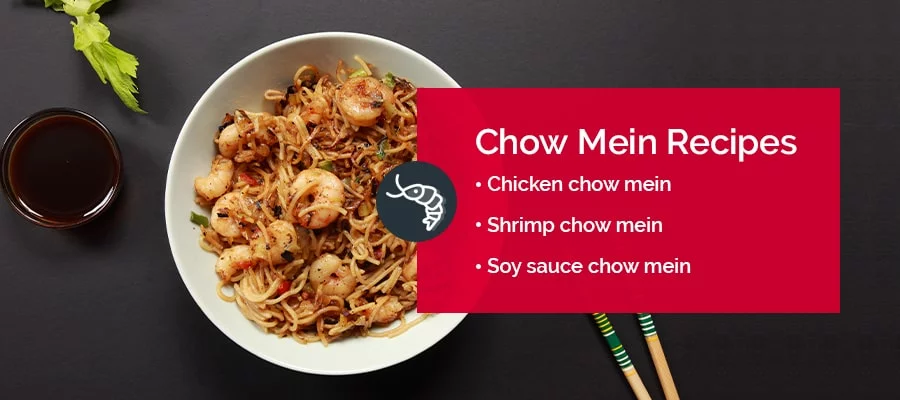
For a more precise set of ingredients, try one of these traditional chow mein recipes:
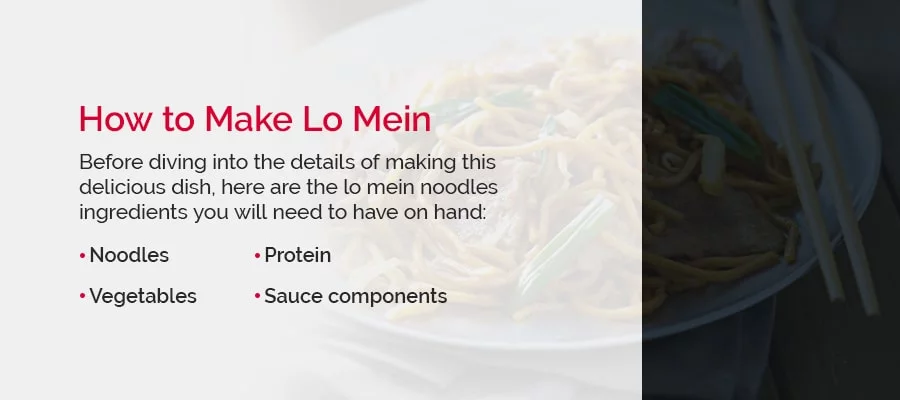
Lo mein offers all the same benefits as chow mein — versatility, a simple sauce, quick and easy cooking and disguised vegetables — but follows a slightly different cooking technique. For lo mein, noodles are not fried. Instead, fully cooked egg noodles are tossed with pre-stir-fried vegetables and protein. Lo mein is also loaded with more sauce to stick to the soft, plump noodles.
Before diving into the details of making this delicious dish, here are the lo mein noodles ingredients you will need to have on hand:
Once you’ve assembled your ingredients, follow these steps to make the perfect lo mein:
The defining feature of any lo mein dish is the sauce, so make sure you take the time to get it right. Using dark soy sauce will give the lo mein color and a bolder taste while adding light soy sauce will give the dish some extra saltiness and flavor without staining the noodles darker. For a more intense savory flavor, consider using Tamari, which uses more soy protein to create a richer, more complex taste.
Because the sauce is the star ingredient of lo mein, this dish will be drenched in much more sauce than chow mein. The thick and chewy fresh egg noodles perfectly complement the lo mein sauce by soaking up the sauce. These plump and soft noodles are also suitable for wrapping around chopsticks, making them the ideal lo mein noodle.
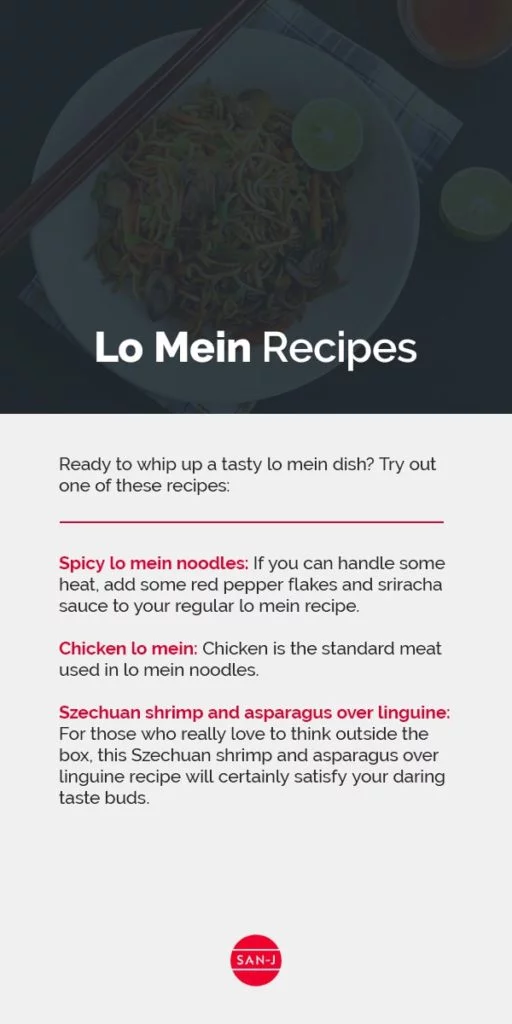
Ready to whip up a tasty lo mein dish? Try out one of these recipes:
FAQ
What is Chinese yee mein?
Is lo mein or chow mein better?